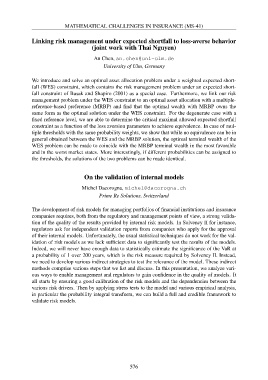Page 578 - 8th European Congress of Mathematics ∙ 20-26 June 2021 ∙ Portorož, Slovenia ∙ Book of Abstracts
P. 578
MATHEMATICAL CHALLENGES IN INSURANCE (MS-41)
Linking risk management under expected shortfall to loss-averse behavior
(joint work with Thai Nguyen)
An Chen, an.chen@uni-ulm.de
University of Ulm, Germany
We introduce and solve an optimal asset allocation problem under a weighted expected short-
fall (WES) constraint, which contains the risk management problem under an expected short-
fall constraint of Basak and Shapiro (2001) as a special case. Furthermore, we link our risk
management problem under the WES constraint to an optimal asset allocation with a multiple-
reference-based preference (MRBP) and find that the optimal wealth with MRBP owns the
same form as the optimal solution under the WES constraint. For the degenerate case with a
fixed reference level, we are able to determine the critical maximal allowed expected shortfall
constraint as a function of the loss aversion parameters to achieve equivalence. In case of mul-
tiple thresholds with the same probability weights, we show that while no equivalence can be in
general obtained between the WES and the MRBP solution, the optimal terminal wealth of the
WES problem can be made to coincide with the MRBP terminal wealth in the most favorable
and in the worst market states. More interestingly, if different probabilities can be assigned to
the thresholds, the solutions of the two problems can be made identical.
On the validation of internal models
Michel Dacorogna, michel@dacorogna.ch
Prime Re Solutions, Switzerland
The development of risk models for managing portfolios of financial institutions and insurance
companies requires, both from the regulatory and management points of view, a strong valida-
tion of the quality of the results provided by internal risk models. In Solvency II for instance,
regulators ask for independent validation reports from companies who apply for the approval
of their internal models. Unfortunately, the usual statistical techniques do not work for the val-
idation of risk models as we lack sufficient data to significantly test the results of the models.
Indeed, we will never have enough data to statistically estimate the significance of the VaR at
a probability of 1 over 200 years, which is the risk measure required by Solvency II. Instead,
we need to develop various indirect strategies to test the relevance of the model. These indirect
methods comprise various steps that we list and discuss. In this presentation, we analyze vari-
ous ways to enable management and regulators to gain confidence in the quality of models. It
all starts by ensuring a good calibration of the risk models and the dependencies between the
various risk drivers. Then by applying stress tests to the model and various empirical analysis,
in particular the probability integral transform, we can build a full and credible framework to
validate risk models.
576
Linking risk management under expected shortfall to loss-averse behavior
(joint work with Thai Nguyen)
An Chen, an.chen@uni-ulm.de
University of Ulm, Germany
We introduce and solve an optimal asset allocation problem under a weighted expected short-
fall (WES) constraint, which contains the risk management problem under an expected short-
fall constraint of Basak and Shapiro (2001) as a special case. Furthermore, we link our risk
management problem under the WES constraint to an optimal asset allocation with a multiple-
reference-based preference (MRBP) and find that the optimal wealth with MRBP owns the
same form as the optimal solution under the WES constraint. For the degenerate case with a
fixed reference level, we are able to determine the critical maximal allowed expected shortfall
constraint as a function of the loss aversion parameters to achieve equivalence. In case of mul-
tiple thresholds with the same probability weights, we show that while no equivalence can be in
general obtained between the WES and the MRBP solution, the optimal terminal wealth of the
WES problem can be made to coincide with the MRBP terminal wealth in the most favorable
and in the worst market states. More interestingly, if different probabilities can be assigned to
the thresholds, the solutions of the two problems can be made identical.
On the validation of internal models
Michel Dacorogna, michel@dacorogna.ch
Prime Re Solutions, Switzerland
The development of risk models for managing portfolios of financial institutions and insurance
companies requires, both from the regulatory and management points of view, a strong valida-
tion of the quality of the results provided by internal risk models. In Solvency II for instance,
regulators ask for independent validation reports from companies who apply for the approval
of their internal models. Unfortunately, the usual statistical techniques do not work for the val-
idation of risk models as we lack sufficient data to significantly test the results of the models.
Indeed, we will never have enough data to statistically estimate the significance of the VaR at
a probability of 1 over 200 years, which is the risk measure required by Solvency II. Instead,
we need to develop various indirect strategies to test the relevance of the model. These indirect
methods comprise various steps that we list and discuss. In this presentation, we analyze vari-
ous ways to enable management and regulators to gain confidence in the quality of models. It
all starts by ensuring a good calibration of the risk models and the dependencies between the
various risk drivers. Then by applying stress tests to the model and various empirical analysis,
in particular the probability integral transform, we can build a full and credible framework to
validate risk models.
576


